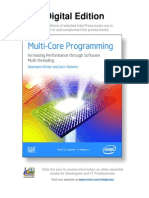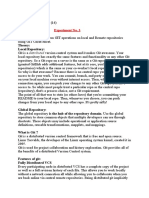0 ratings0% found this document useful (0 votes)
552 viewsAn Introduction To Parallel Programming - Lecture Notes, Study Material and Important Questions, Answers
All Topics with neat figure(Diagram) and Explanation. Important Questions and answers.
An Introduction to Parallel Programming - Lecture Notes, Study Material and Important Questions, Answers
Uploaded by
M.V. TVCopyright
© © All Rights Reserved
We take content rights seriously. If you suspect this is your content, claim it here.
Available Formats
Download as PDF, TXT or read online on Scribd
0 ratings0% found this document useful (0 votes)
552 viewsAn Introduction To Parallel Programming - Lecture Notes, Study Material and Important Questions, Answers
All Topics with neat figure(Diagram) and Explanation. Important Questions and answers.
An Introduction to Parallel Programming - Lecture Notes, Study Material and Important Questions, Answers
Uploaded by
M.V. TVCopyright
© © All Rights Reserved
We take content rights seriously. If you suspect this is your content, claim it here.
Available Formats
Download as PDF, TXT or read online on Scribd
You are on page 1/ 4
An Introduction to Parallel Programming
Subject : An Introduction to Parallel Programming
Chapter 1 Why Parallel Computing
1. Why Parallel Computing? - Answer (click here)
2. Why We Need Ever-Increasing Performance - Answer (click here)
3. Why We’re Building Parallel Systems - Answer (click here)
4. Why we Need to Write Parallel Programs - Answer (click here)
5. How Do We Write Parallel Programs? - Answer (click here)
6. Concurrent, Parallel, Distributed - Answer (click here)
Chapter 2 Parallel Hardware and Parallel Software
1. Why Parallel Computing? - Answer (click here)
2. Why We Need Ever-Increasing Performance - Answer (click here)
3. Why We’re Building Parallel Systems - Answer (click here)
4. Why we Need to Write Parallel Programs - Answer (click here)
5. How Do We Write Parallel Programs? - Answer (click here)
6. Concurrent, Parallel, Distributed - Answer (click here)
7. Parallel Hardware and Parallel Software - Answer (click here)
8. Some Background: von Neumann architecture, Processes, multitasking,
and threads - Answer (click here)
9. Modifications to the Von Neumann Model - Answer (click here)
10. Parallel Hardware - Answer (click here)
11. Parallel Software - Answer (click here)
12. Input and Output - Answer (click here)
13. Performance of Parallel Programming - Answer (click here)
14. Parallel Program Design with example - Answer (click here)
15. Writing and Running Parallel Programs - Answer (click here)
16. Assumptions - Parallel Programming - Answer (click here)
Chapter 3 Distributed Memory Programming with MPI
1. Why Parallel Computing? - Answer (click here)
2. Why We Need Ever-Increasing Performance - Answer (click here)
3. Why We’re Building Parallel Systems - Answer (click here)
4. Why we Need to Write Parallel Programs - Answer (click here)
5. How Do We Write Parallel Programs? - Answer (click here)
6. Concurrent, Parallel, Distributed - Answer (click here)
7. Parallel Hardware and Parallel Software - Answer (click here)
8. Some Background: von Neumann architecture, Processes, multitasking,
and threads - Answer (click here)
9. Modifications to the Von Neumann Model - Answer (click here)
10. Parallel Hardware - Answer (click here)
11. Parallel Software - Answer (click here)
12. Input and Output - Answer (click here)
13. Performance of Parallel Programming - Answer (click here)
14. Parallel Program Design with example - Answer (click here)
15. Writing and Running Parallel Programs - Answer (click here)
16. Assumptions - Parallel Programming - Answer (click here)
17. Distributed-Memory Programming with MPI - Answer (click here)
18. The Trapezoidal Rule in MPI - Answer (click here)
19. Dealing with I/O - Answer (click here)
20. Collective Communication - Answer (click here)
21. MPI Derived Datatypes - Answer (click here)
22. Performance Evaluation of MPI Programs - Answer (click here)
23. A Parallel Sorting Algorithm - Answer (click here)
Chapter 4 Shared Memory Programming with Pthreads
1. Why Parallel Computing? - Answer (click here)
2. Why We Need Ever-Increasing Performance - Answer (click here)
3. Why We’re Building Parallel Systems - Answer (click here)
4. Why we Need to Write Parallel Programs - Answer (click here)
5. How Do We Write Parallel Programs? - Answer (click here)
6. Concurrent, Parallel, Distributed - Answer (click here)
7. Parallel Hardware and Parallel Software - Answer (click here)
8. Some Background: von Neumann architecture, Processes, multitasking,
and threads - Answer (click here)
9. Modifications to the Von Neumann Model - Answer (click here)
10. Parallel Hardware - Answer (click here)
11. Parallel Software - Answer (click here)
12. Input and Output - Answer (click here)
13. Performance of Parallel Programming - Answer (click here)
14. Parallel Program Design with example - Answer (click here)
15. Writing and Running Parallel Programs - Answer (click here)
16. Assumptions - Parallel Programming - Answer (click here)
17. Distributed-Memory Programming with MPI - Answer (click here)
18. The Trapezoidal Rule in MPI - Answer (click here)
19. Dealing with I/O - Answer (click here)
20. Collective Communication - Answer (click here)
21. MPI Derived Datatypes - Answer (click here)
22. Performance Evaluation of MPI Programs - Answer (click here)
23. A Parallel Sorting Algorithm - Answer (click here)
24. Shared-Memory Programming with Pthreads - Answer (click here)
25. Processes, Threads, and Pthreads - Answer (click here)
26. Pthreads - Hello, World Program - Answer (click here)
27. Matrix-Vector Multiplication - Answer (click here)
28. Critical Sections - Answer (click here)
29. Busy-Waiting - Answer (click here)
30. Mutexes - Answer (click here)
31. Producer-Consumer Synchronization and Semaphores - Answer (click here)
32. Barriers and Condition Variables - Answer (click here)
33. Read-Write Locks - Answer (click here)
34. Caches, Cache Coherence, and False Sharing - Answer (click here)
35. Thread-Safety - Answer (click here)
36. Shared-Memory Programming with OpenMP - Answer (click here)
37. The Trapezoidal Rule - Answer (click here)
38. Scope of Variables - Answer (click here)
39. The Reduction Clause - Answer (click here)
40. The parallel For Directive - Answer (click here)
41. More About Loops in Openmp: Sorting - Answer (click here)
42. Scheduling Loops - Answer (click here)
43. Producers and Consumers - Answer (click here)
44. Caches, Cache Coherence, and False Sharing - Answer (click here)
45. Thread-Safety - Answer (click here)
46. Parallel Program Development - Answer (click here)
47. Two n-Body Solvers - Answer (click here)
48. Parallelizing the basic solver using OpenMP - Answer (click here)
49. Parallelizing the reduced solver using OpenMP - Answer (click here)
50. Evaluating the OpenMP codes - Answer (click here)
51. Parallelizing the solvers using pthreads - Answer (click here)
52. Parallelizing the basic solver using MPI - Answer (click here)
53. Parallelizing the reduced solver using MPI - Answer (click here)
54. Performance of the MPI solvers - Answer (click here)
55. Tree Search - Answer (click here)
56. Recursive depth-first search - Answer (click here)
57. Nonrecursive depth-first search - Answer (click here)
58. Data structures for the serial implementations - Answer (click here)
59. Performance of the serial implementations - Answer (click here)
60. Parallelizing tree search - Answer (click here)
61. A static parallelization of tree search using pthreads - Answer (click here)
62. A dynamic parallelization of tree search using pthreads - Answer (click
here)
63. Evaluating the Pthreads tree-search programs - Answer (click here)
64. Parallelizing the tree-search programs using OpenMP - Answer (click here)
65. Performance of the OpenMP implementations - Answer (click here)
66. Implementation of tree search using MPI and static partitioning - Answer
(click here)
67. Implementation of tree search using MPI and dynamic partitioning -
Answer (click here)
68. Which API? - Answer (click here)
You might also like
- Nursing - Lecture Notes, Study Material and Important Questions, Answers50% (2)Nursing - Lecture Notes, Study Material and Important Questions, Answers4 pages
- Apache Cassandra Administrator Associate - Exam Practice TestsFrom EverandApache Cassandra Administrator Associate - Exam Practice TestsNo ratings yet
- Introduction To Compiler Design - Solutions0% (1)Introduction To Compiler Design - Solutions23 pages
- The Massage Connection Anatomy and Physiology - Lecture Notes, Study Material and Important Questions, Answers100% (1)The Massage Connection Anatomy and Physiology - Lecture Notes, Study Material and Important Questions, Answers63 pages
- Zoology - Lecture Notes, Study Material and Important Questions, Answers100% (2)Zoology - Lecture Notes, Study Material and Important Questions, Answers71 pages
- LAB Manual: Course: CSC271: Database SystemsNo ratings yetLAB Manual: Course: CSC271: Database Systems55 pages
- COSC2429 - Intro To Programming Assessment 2 - Sem A 2021: RMIT Classification: Trusted100% (1)COSC2429 - Intro To Programming Assessment 2 - Sem A 2021: RMIT Classification: Trusted3 pages
- Power Quality - Lecture Notes, Study Material and Important Questions, Answers50% (6)Power Quality - Lecture Notes, Study Material and Important Questions, Answers5 pages
- Power System Analysis - Lecture Notes, Study Material and Important Questions, Answers50% (2)Power System Analysis - Lecture Notes, Study Material and Important Questions, Answers5 pages
- VLSI Design - Lecture Notes, Study Material and Important Questions, AnswersNo ratings yetVLSI Design - Lecture Notes, Study Material and Important Questions, Answers9 pages
- Television and Video Engineering - Lecture Notes, Study Material and Important Questions, AnswersNo ratings yetTelevision and Video Engineering - Lecture Notes, Study Material and Important Questions, Answers7 pages
- Security in Computing - Lecture Notes, Study Material and Important Questions, AnswersNo ratings yetSecurity in Computing - Lecture Notes, Study Material and Important Questions, Answers38 pages
- Computer Architecture 3rd Edition by Moris ManoCh 10No ratings yetComputer Architecture 3rd Edition by Moris ManoCh 1021 pages
- Multi-Core Programming Digital Edition (06!29!06)No ratings yetMulti-Core Programming Digital Edition (06!29!06)362 pages
- Parallel and Distributed Computing Lecture 02No ratings yetParallel and Distributed Computing Lecture 0217 pages
- Chapter 3 Boolean Anlgebra and Logi GatesNo ratings yetChapter 3 Boolean Anlgebra and Logi Gates59 pages
- Parallel and Distributed Computing Architectures A PDFNo ratings yetParallel and Distributed Computing Architectures A PDF286 pages
- Step1. Open The Data/bank Data - CSV DatasetNo ratings yetStep1. Open The Data/bank Data - CSV Dataset3 pages
- Vtu 4TH Sem Cse Computer Organization Notes 10CS46100% (12)Vtu 4TH Sem Cse Computer Organization Notes 10CS4675 pages
- Computer and Network Security: Simplified Data Encryption Standard (DES)No ratings yetComputer and Network Security: Simplified Data Encryption Standard (DES)21 pages
- Experiment No.: 2: AIM: To Perform Encoding and Decoding For Hamming Code. APPARATUS: Scilab. TheoryNo ratings yetExperiment No.: 2: AIM: To Perform Encoding and Decoding For Hamming Code. APPARATUS: Scilab. Theory4 pages
- Write A Programme To Parse Using Brute Force Technique of Topdown ParsingNo ratings yetWrite A Programme To Parse Using Brute Force Technique of Topdown Parsing3 pages
- The Architecture of Pentium MicroprocessorNo ratings yetThe Architecture of Pentium Microprocessor26 pages
- Computer Organization and Assembly LanguageNo ratings yetComputer Organization and Assembly Language51 pages
- M1 - IT 212 - Logic Design and Digital Computer CircuitsNo ratings yetM1 - IT 212 - Logic Design and Digital Computer Circuits4 pages
- Artificial Intelligence (AI2002) Course Outline Spring 2023No ratings yetArtificial Intelligence (AI2002) Course Outline Spring 20232 pages
- Minimization of Finite Automata: Computer Engineering Department B. E. Iii, Co - E, 6 Semester (EVEN - 2018)No ratings yetMinimization of Finite Automata: Computer Engineering Department B. E. Iii, Co - E, 6 Semester (EVEN - 2018)21 pages
- Sir Syed University of Engineering and TechnologyNo ratings yetSir Syed University of Engineering and Technology4 pages
- Unit - Viii Machine Dependent Code Optimization Peephole OptimizationNo ratings yetUnit - Viii Machine Dependent Code Optimization Peephole Optimization9 pages
- Aim: To Implement First Pass of Two Pass Assembler For IBM 360/370 Objective: Develop A Program To Implement First PassNo ratings yetAim: To Implement First Pass of Two Pass Assembler For IBM 360/370 Objective: Develop A Program To Implement First Pass4 pages
- Lecture Notes On: Theory of Computation Module - 2 Unit - 1No ratings yetLecture Notes On: Theory of Computation Module - 2 Unit - 152 pages
- Keyboard Interfacing in 8085 - ComputerSCNo ratings yetKeyboard Interfacing in 8085 - ComputerSC4 pages
- Assembler Directive in Microprocesser 8086100% (1)Assembler Directive in Microprocesser 808618 pages
- Mbbs - Lecture Notes, Study Material and Important Questions, Answers75% (4)Mbbs - Lecture Notes, Study Material and Important Questions, Answers4 pages
- The Complete Reference Java - Lecture Notes, Study Material and Important Questions, AnswersNo ratings yetThe Complete Reference Java - Lecture Notes, Study Material and Important Questions, Answers208 pages
- Pharmacology - Lecture Notes, Study Material and Important Questions, AnswersNo ratings yetPharmacology - Lecture Notes, Study Material and Important Questions, Answers236 pages
- Pharmaceutical Biotechnology Fundamentals and Applications - Lecture Notes, Study Material and Important Questions, Answers100% (1)Pharmaceutical Biotechnology Fundamentals and Applications - Lecture Notes, Study Material and Important Questions, Answers141 pages
- Transforms and Partial Differential Equations - Lecture Notes, Study Material and Important Questions, AnswersNo ratings yetTransforms and Partial Differential Equations - Lecture Notes, Study Material and Important Questions, Answers4 pages
- Pharmacology - Lecture Notes, Study Material and Important Questions, Answers100% (2)Pharmacology - Lecture Notes, Study Material and Important Questions, Answers52 pages
- Power Plant Engineering - Lecture Notes, Study Material and Important Questions, Answers100% (3)Power Plant Engineering - Lecture Notes, Study Material and Important Questions, Answers12 pages
- Plant Biochemistry - Lecture Notes, Study Material and Important Questions, AnswersNo ratings yetPlant Biochemistry - Lecture Notes, Study Material and Important Questions, Answers70 pages
- Pharmaceutical Drug Analysis - Lecture Notes, Study Material and Important Questions, Answers100% (2)Pharmaceutical Drug Analysis - Lecture Notes, Study Material and Important Questions, Answers81 pages
- Physics For Civil Engineering - Lecture Notes, Study Material and Important Questions, Answers0% (1)Physics For Civil Engineering - Lecture Notes, Study Material and Important Questions, Answers3 pages
- Plant Anatomy - Lecture Notes, Study Material and Important Questions, Answers67% (3)Plant Anatomy - Lecture Notes, Study Material and Important Questions, Answers11 pages
- Total Quality Management - Lecture Notes, Study Material and Important Questions, Answers100% (3)Total Quality Management - Lecture Notes, Study Material and Important Questions, Answers8 pages
- Transmission Lines and Wave Guides - Lecture Notes, Study Material and Important Questions, AnswersNo ratings yetTransmission Lines and Wave Guides - Lecture Notes, Study Material and Important Questions, Answers5 pages
- Physics For Information Science - Lecture Notes, Study Material and Important Questions, Answers100% (1)Physics For Information Science - Lecture Notes, Study Material and Important Questions, Answers6 pages
- Web Technology - Lecture Notes, Study Material and Important Questions, AnswersNo ratings yetWeb Technology - Lecture Notes, Study Material and Important Questions, Answers5 pages
- Water Resources and Irrigation Engineering - Lecture Notes, Study Material and Important Questions, AnswersNo ratings yetWater Resources and Irrigation Engineering - Lecture Notes, Study Material and Important Questions, Answers9 pages
- Operations Research An Introduction - Lecture Notes, Study Material and Important Questions, AnswersNo ratings yetOperations Research An Introduction - Lecture Notes, Study Material and Important Questions, Answers13 pages
- Mobile Computing - Lecture Notes, Study Material and Important Questions, AnswersNo ratings yetMobile Computing - Lecture Notes, Study Material and Important Questions, Answers4 pages
- Mobile and Pervasive Computing - Lecture Notes, Study Material and Important Questions, AnswersNo ratings yetMobile and Pervasive Computing - Lecture Notes, Study Material and Important Questions, Answers5 pages
- Solid State Drives - Lecture Notes, Study Material and Important Questions, AnswersNo ratings yetSolid State Drives - Lecture Notes, Study Material and Important Questions, Answers4 pages
- Technical English - Lecture Notes, Study Material and Important Questions, AnswersNo ratings yetTechnical English - Lecture Notes, Study Material and Important Questions, Answers4 pages
- Surveying - Lecture Notes, Study Material and Important Questions, Answers100% (1)Surveying - Lecture Notes, Study Material and Important Questions, Answers8 pages
- Red Hat Enterprise Linux-7-Kernel Administration Guide-En-USNo ratings yetRed Hat Enterprise Linux-7-Kernel Administration Guide-En-US73 pages
- Define the concept of multiple access. Discuss the basic idea of FDMA, TDMA, CDMA and OFDMA - بحث GoogleNo ratings yetDefine the concept of multiple access. Discuss the basic idea of FDMA, TDMA, CDMA and OFDMA - بحث Google1 page
- PHP & Mysql: It84 - It Elective 1 (PHP Programming)No ratings yetPHP & Mysql: It84 - It Elective 1 (PHP Programming)17 pages
- Name: Sonam Gupta Roll No.: 201903015 (14) Subject: Devops Lab100% (1)Name: Sonam Gupta Roll No.: 201903015 (14) Subject: Devops Lab8 pages
- SN-IES-1-002 - RTE - OS - Invocation - RTE - Handling - of - Runnable - Mappings - On - Different - Task - TypesNo ratings yetSN-IES-1-002 - RTE - OS - Invocation - RTE - Handling - of - Runnable - Mappings - On - Different - Task - Types6 pages
- DIGITAL ELECTRONICS Lecture Notes 1 - 071216No ratings yetDIGITAL ELECTRONICS Lecture Notes 1 - 07121618 pages
- Dell Vostro 1320 Compal LA-4232P Rev 1.0 Schematics PDFNo ratings yetDell Vostro 1320 Compal LA-4232P Rev 1.0 Schematics PDF48 pages
- AZS - MF - SEPM - Deploy - Configuration - 1.0No ratings yetAZS - MF - SEPM - Deploy - Configuration - 1.011 pages
- Operating System (Types of Operating System) : Department of Computer Science University of Swabi (Khyber Pakhtunkhwa)No ratings yetOperating System (Types of Operating System) : Department of Computer Science University of Swabi (Khyber Pakhtunkhwa)27 pages
- SalesMgmtSystem XII IP Projectreport 2022 23No ratings yetSalesMgmtSystem XII IP Projectreport 2022 2318 pages
- BDA GTU Study Material Presentations Unit-4 29092021094703AMNo ratings yetBDA GTU Study Material Presentations Unit-4 29092021094703AM33 pages
- Smart Facial Recognition Attendance System Using ESP32 CamNo ratings yetSmart Facial Recognition Attendance System Using ESP32 Cam3 pages
- PCI Express 1x, 4x, 8x, 16x Bus Pinout Diagram @No ratings yetPCI Express 1x, 4x, 8x, 16x Bus Pinout Diagram @1 page























































































































